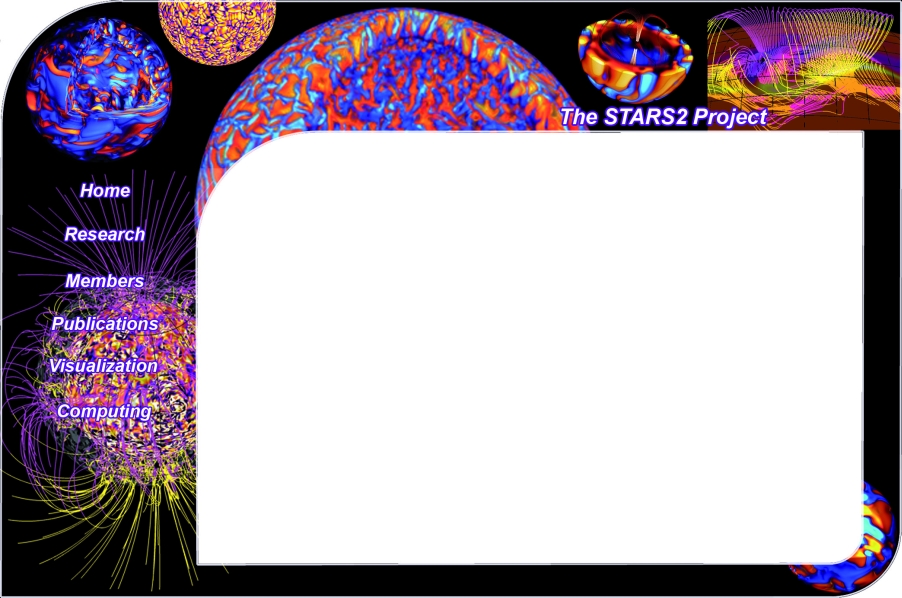Software
ASH: The anelastic spherical harmonic (ASH) code solves the three- dimensional anelastic equations of motion in a rotating spherical geometry using a pseudospectral semi-implicit approach (Clune et al. 1999; Brun, Miesch & Toomre 2004). These equations are fully nonlinear in velocity variables and linearized in thermodynamic variables with respect to a spherically symmetric mean state. Velocity, thermodynamic (and magnetic if present) variables within ASH are expanded in spherical harmonics Yml(theta,phi) in the horizontal directions and in Chebyshev polynomials Tn (r) in the radial direction. Spatial resolution is thus uniform everywhere on a sphere when a complete set of spherical harmonics of degree l is used, retaining all azimuthal orders m. We truncate our expansion at degree l=lmax, which is related to the number of latitudinal mesh points Ntheta (here lmax=(2Ntheta-1)/ 3), take Nphi=2 Ntheta azimuthal mesh points, and utilize Nr collocation points for the projection onto the Chebyshev polynomials. We have considered various grid resolutions Nr times Ntheta times Nphi; depending on the degree of turbulence of the model. A semi-implicit, second-order Crank-Nicolson scheme is used in determining the time evolution of the linear terms, whereas an explicit second-order Adams-Bashforth scheme is employed for the advective and Coriolis terms. The ASH code has been optimized to run efficiently on massively parallel supercomputers such as the IBM SP-6 or SGI Altix, and has demonstrated excellent scalability on such machines.
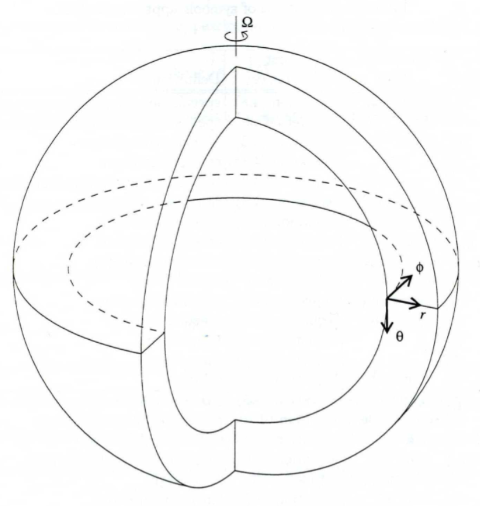
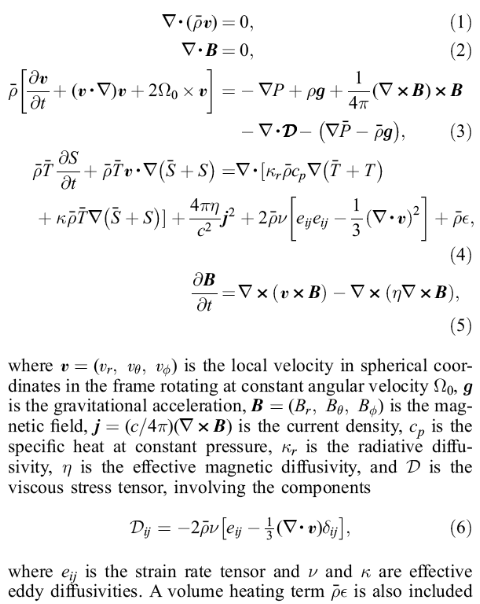
Anelastic convection-driven dynamo benchmarks
C.A. Jones , P. Boronski , A.S. Brun , G.A. Glatzmaier , T. Gastine , M.S. Miesch , J. Wicht
Icarus 216 (2011) 120-135
GLOBAL-SCALE TURBULENT CONVECTION AND MAGNETIC DYNAMO ACTION IN THE SOLAR ENVELOPE
A.S.Brun, M.S.Miesch, J.Toomre
The Astrophysical Journal, 614:1073, 2004 October 20
STELEM: The STELEM (STellar ELEMemts) code uses a finite elements method in space and a third order scheme in time (Burnett 1987, Emonet & Charbonneau 1998, Jouve & Brun 2007). The code solves equations (1) and (2) by seeking the approximate solutions Aphi; and Bphi as linear combinations of trial functions psi i(r,theta) (Lagrange polynomials of degree 1 (linear functions) for 1st order interpolation). The coefficients of the 2 linear combinations are dependent on time only. The main steps of the method are the following: Our domain (defined by rb <= r <= Ro, 0 <= theta <= pi) is divided into smaller regions called it elements. These elements are quadrilaterals with a node at each corner when the trial functions are 1st order Lagrange polynomials. item In each element, the PDEs are transformed into ordinary differential equations in time involving the coefficients of the linear combinations. item The terms in the element equations are numerically evaluated for each element in the mesh. The resulting numbers are assembled into a much larger set of equations called the system equations. The boundary conditions are taken into account. They are here of Dirichlet type: the top boundary condition is a potentiel field or purely radial field. At the bottom we assume perfect conductor. The temporal scheme that we use is adapted from Spalart et al. 1991. The 3 steps of this explicit scheme enable us to get an error as small as o(Delta t3) (see Jouve & Brun 2007).
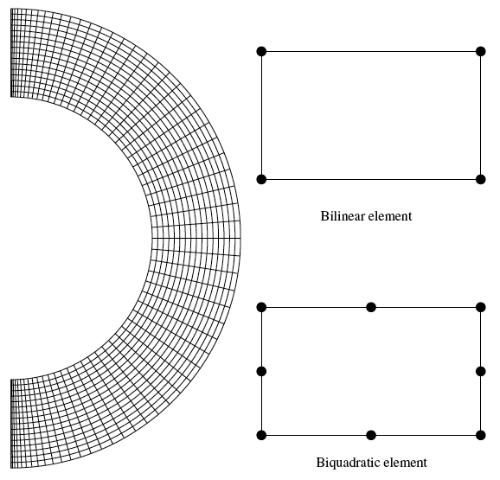
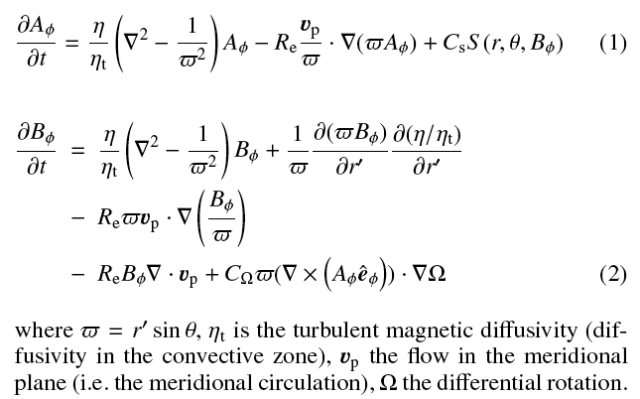
A solar mean field dynamo benchmark
L. Jouve, A. S. Brun, R. Arlt, A. Brandenburg, M. Dikpati, A. Bonanno, P. J. Kapyla, D. Moss, M. Rempel, P. Gilman, M. J. Korpi, and A. G. Kosovichev
A&A 483, 949-960 (2008)
Hardware
The OXAL Machine (description in french)
Dans le cadre du projet STARS2, qui a pour objectif de comprendre la dynamique non lineaire des plasmas stellaires, le projet STARS2 a besoin de se doter d'un gros serveur de calcul/graphique permettant de traiter, d'analyser et de visualiser (en 2-D, 3-D et 3-D relief) les donnees.
Solution : Serveur DL580 G7 equipe de 4 processeurs Intel Xeon Nehalem EX Octo coeurs X7560 2,27Ghz, 135W, 24Mo cache L3, depassant les 480 SPECfp rate 2006.
Le reste de la configuration du serveur est la suivante :
-- 512 Go de RAM: 32 kits de 16Go DDR3 PC3 (evolutif a 1To)
-- 5 disques SAS 300Go 10 Ktpm 2 port SFF 2,5" hp
-- 6 interfaces Gigabit Ethernet (PXE)
-- Interface iLO pour la supervision
-- Lecteur graveur DVD+RW
-- Controleur Raid HP P411/512 BBWC connecte a une baie de stockage MSA60 integrant 10 disques SATA de 2To, soit 20To brut
-- Carte Nividia Quadro 6000 compatible OpenGL 6Go
-- 4 Alimentations hot plug 1200W
-- Support HP de 3 ans sur site J+1
-- Logiciel de deport d'ecran HP RGS
-- Systeme d'exploitation Linux CentOS
